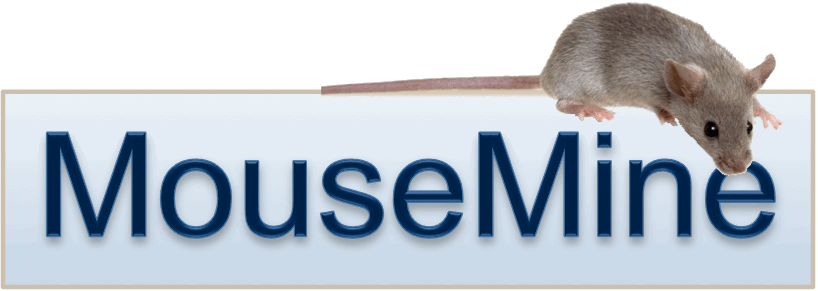
MouseMine
Integrated mouse data. Populated by MGI, powered by InterMine.
TEST
MGI update: 2024-05-21

Integrated mouse data. Populated by MGI, powered by InterMine.
TEST
MGI update: 2024-05-21
MouseMine contains a subset of the data from MGI, concentrating on essential mouse genomic information, MGI-curated annotations (GO, MP, OMIM), and supporting publications, external database references, and curator notes. Human and comparative data (human genes, coordinates, OMIM annotations, Homologene clusters) are included as well. MouseMine also contains some data not currently found in MGI, including the Disease Ontology and mouse/human synteny blocks. Over time, we will expand MouseMine's data coverage to include more of MGI (e.g., sequences), as well as selected additional data (e.g. pathways). For more information, see About MouseMine.
| Data Category | Data | Source |
|---|---|---|
|
Genome |
Mouse genome feature catalog. All canonical mouse genes and other genome features from MGI, including nomenclature, synonyms, genome coordinates and cross-references (external database IDs). | MGI |
| Multiple strain genomes. Complete genomes for 19 mouse inbred strains. Includes chromosome assembly sequences and genome annotations. Features in each strain's genome are connected to the canonical (MGI) gene, and vice versa. | Mouse Genomes Project (MGP) and ENSEMBL | |
| Human genes, including symbols, names, ids, and genome coordinates. | MGI | |
| Genes from other model organisms, including symbols, names, ids, and genome coordinates. | FlyMine RatMine WormMine YeastMine ZebrafishMine | |
|
Proteins |
Mouse proteins and protein fragments, including sequences, keywords, identifiers, etc. | UniProt |
| Association of mouse proteins to mouse genes. NOTE: due to a limitation in the data model, MouseMine does NOT currently contain associations of proteins to non-gene features (e.g., gene segments). | MGI | |
| Protein domains annotated to specific protein regions. | InterPro | |
Function |
Mouse GO annotations. High quality associations of mouse genes (and other features) to biological processes, molecular functions, and cellular localizations. |
MGI
GO@MGI |
| Gene Ontology (GO). | Gene Ontology project. | |
Expression |
Expression annotations. Results from assays of endogenous gene expression in wild type and mutant mice. | GXD (Gene Expression Database) @MGI |
| EMAPA anatomy ontology. EMAPA is the abstract (stage-aggregated) mouse developmental anatomy ontology, developed by the Edinburgh Mouse Atlas Project. | EMAP (Edinburgh Mouse Atlas Project) and GXD | |
Interactions |
Mouse and human protein-protein interaction data from BioGrid and IntAct. |
BioGrid
IntAct |
| Mouse micro RNA (miRNA) interaction data from MGI. | MGI | |
|
Pathways |
Pathways and their associations to genes and proteins. | Reactome |
Phenotype |
The MGI catalog of mouse alleles, including targeted, engineered, induced, and spontaneous mutants. | MGI |
| Phenotypes (MP terms) annotated to specific mouse genotypes. From these, additional annotations are computed (derived) from phenotypes to mouse genes and alleles. | ||
| Mammalian Phenotype (MP) ontology | ||
Disease |
The Disease Ontology (DO) is a standardized ontology of human disease terms, phenotype characteristics and related medical vocabulary disease concepts. DO terms are heavily cross-referenced to other disease vocabularies, e.g. OMIM, MeSH, SNOMED, and more. MouseMine supports searching by any of these id types. | Disease Ontology project. |
| Mouse disease model annotations, i.e., associations of human diseases (DO terms) to specific mouse models (genotypes). From these, additional annotations are computed (derived) from diseases to mouse genes and alleles. | MGI | |
| Human disease-to-gene annotations, i.e., associations of human genes with specific diseases (DO terms). | OMIM (via MGI) | |
Homology |
Mouse-Human Orthologies | Homologene and Panther |
| Mouse-Human Synteny Blocks. Computed/extrapolated from ortholog pairs and their coordinates. (Usage note: InterMine does not yet provide any facilities for mapping (interpolating) coordinates using synteny blocks. Implementation of such a service is on the "to do" list.) | MGI | |
Literature |
All publications from MGI. | MGI |